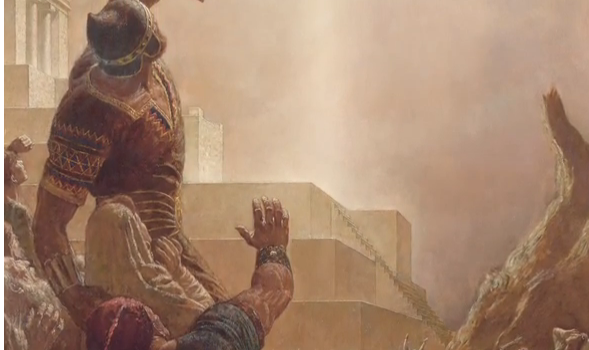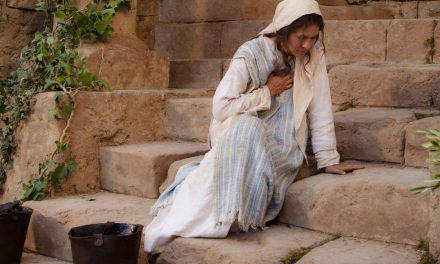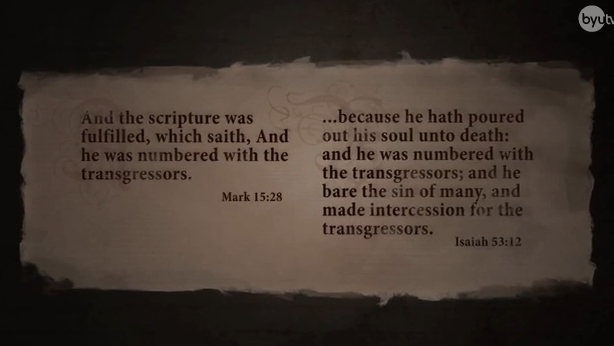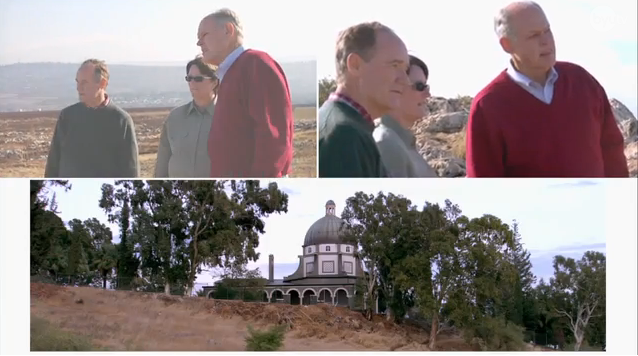JUSTIN SU’A: “Reach hither thy finger, and behold my hands; and reach hither thy hand, and thrust it into my side: and be not faithless, but believing” (John 20:27). Those who have the opportunity to not only hear and feel but to touch, they’re given such a great testimony of the divinity of the resurrected Savior. However, the Lord goes on to give Thomas additional doctrine. He says: “Blessed are they that have not seen, and yet have believed” (John 20:29). We can apply that to our lives, that we might not have had the opportunity to see the Lord. We have not had the opportunity to touch the resurrected Savior. But if we believe without seeing; if we have faith that He is the resurrected Lord, and believe in His teachings, we too can receive those same promises and blessings and testimony, that those who have seen, heard, and touched him have received.
CECILIA M. PEEK: The fact that we see their doubts, and recognize, I think, their doubts as part of the human experience of developing faith, is a critical part of the Gospel accounts. Because it indicates a kind of humility on their part, a kind of willingness to demonstrate that they struggled at times. But also suggests and hints at really the veracity of these accounts. We’re not covering things up; we’re not making this a perfectly finished and ideal representation of our belief. This is how we struggled—how we came to believe. This is how it happens. And this sounds true.
GAYE STRATHEARN: There is something special about the New Testament, as we see Jesus on a day-to-day basis. I think that there’s something important to see Him in the Mary side of Him, the somebody who is most definitely the Son of God without doubt. The passage in John where He goes out and He gives the Bread of Life Sermon, and what a great, great, sacramental discourse. And then at the end it’s got these very poignant statements. It says, And the multitudes left him. Because He wasn’t going to feed them, and so they weren’t interested in Him just teaching them. And then He turns to His apostles and He says, Will you leave me also? (See John 6:67.) And I think, what a poignant moment, right. And then Peter, bless his heart, steps up: “Lord, to whom will we go?” for “we believe and are sure that thou art that Christ, the Son of the living God” (John 6:68–69). But I just feel the pathos of that moment. Even the Son of God, it must have hurt Him to be disappointed, to have the people turn away when He’s given everything for them.
And again, I, I have to come back to myself. You know, if I was there on that day, how would I have responded? Would I have been one of those people who walked away, or would I have been like Peter? I hope dearly that I could have been like Peter, but I don’t really know, right. And so to place myself in that position and to read about the Pharisees and ask, are there ways that I am sometimes a Pharisee? Are there some times that I’m like Thomas? I know for 2000 years Thomas has been remembered for the “Doubting Thomas” part, but I love the passage in John 11 where he says Jesus is going to go up to Bethany, and He knows that it’s dangerous. And Thomas says, Let us go with him also, and if we need to die with him, we’ll die with him (see John 11:16). You know, that part of Thomas, that’s the part that I’d like to remember is that commitment to the Savior. And I want to be like Thomas, I want to be like Peter, I want to be like those apostles who stayed with the Lord, and had ups and downs spiritually without doubt, but ultimately they gave their lives, both living and in death, to the Savior.
“To whom also he shewed himself alive, after his passion, by many infallible proofs, being seen by them forty days, and speaking of the things pertaining to the kingdom of God” (Acts 1:3).
KENT BROWN: Luke mentions the forty days that the disciples, the eleven, spend with Jesus. Part of that we know is spent in Galilee. We know that part of it was spent in Jerusalem. It’s right at the opening of his book of Acts. If one reads across too quickly, one misses it. But in a sense it stands at the midpoint in in his two works. He writes the Gospel of Luke, and he writes the book of Acts. And here it is almost dead center in the middle of all of this.
I see these six weeks as one of the most important training sessions, one of the most important teaching experiences that the Savior ever went through with these men. And I see this as significant for their continuing ministry, because everything now that Luke will narrate in the book of Acts as it runs along, really grows out of this moment. This is the time when Jesus gives His final instructions before His ascension. And He does so over this long period of time.
KERRY MUHLSTEIN: You’ll see a transformation in the apostles here. The apostles, right up unto His death, as they’re growing and progressing spiritually, I believe, are still coming to understand who the Savior is, and that they’re going to be without Him, that the burden of the kingdom is theirs. And after the crucifixion and then the Resurrection, they become new men. I think a key part of this process of the apostles becoming new men is that forty-day ministry, where now they understand what really the Resurrection means, where now they really understand that their time with the Savior is ending.
KENT BROWN: Some people have trouble with the forty-day ministry, as Luke mentions it, as he opens the book of Acts. Because if Jesus isn’t resurrected physically, what is He doing around these eleven apostles? And it seems to me that that becomes the point at which I separate from others. I believe in the physical Resurrection of Jesus, that He stayed around for this forty-day period, training, educating, bringing these apostles up to speed on the doctrines of the kingdom, and the procedures He wanted them to follow. And if I don’t believe in the Resurrection, then I don’t believe in the forty-days. But if one believes in the Resurrection, the forty-days makes sense.
If apocryphal literature is several steps removed from accepted scripture, one more step takes us into the world of legend. Here one does not find truth in individual stories, but in trends or in themes. Oral tradition is persistent, and can give clues about events in veiled and unexpected ways. And in terms of local folklore, one of the most common claims heard from London to Tibet is: “Jesus was here.”
One should not be surprised with evidence that the resurrected Jesus visits other lands and other peoples. During His mortal ministry, He proclaims to opponent and disciple alike, “Other sheep I have, which are not of this fold: them also I must bring, and they shall hear my voice; and there shall be one fold, and one shepherd” (John 10:16). Although it is not clear how many other sheep Jesus intends to visit, one record stands apart as an independent witness of His literal Resurrection.
 TERRY BALL: The title of the Book of Mormon is, “The Book of Mormon, Another Testament of Jesus Christ.” The Book of Mormon was prepared by ancient descendants of Israel, and hidden up to be brought forth at a time when another witness of Christ would be needed. It tells of Christ’s ministry amongst the people here in the New World, another group of sheep that had been separated. It tells of His teachings, of His covenants, of His dealings with those people, and especially of His ministry after His Resurrection among the people. So it’s another testament of Jesus Christ’s Gospel. It fulfills the law of witnesses, that “in the mouth of two or three witnesses shall every word be established” (Doctrine and Covenants 6:28; see Matthew 18:16).
TERRY BALL: The title of the Book of Mormon is, “The Book of Mormon, Another Testament of Jesus Christ.” The Book of Mormon was prepared by ancient descendants of Israel, and hidden up to be brought forth at a time when another witness of Christ would be needed. It tells of Christ’s ministry amongst the people here in the New World, another group of sheep that had been separated. It tells of His teachings, of His covenants, of His dealings with those people, and especially of His ministry after His Resurrection among the people. So it’s another testament of Jesus Christ’s Gospel. It fulfills the law of witnesses, that “in the mouth of two or three witnesses shall every word be established” (Doctrine and Covenants 6:28; see Matthew 18:16).
JUAN HENDERSON: The Bible is the first witness of what the Savior has done in Jerusalem. The Book of Mormon comes forth as a second witness that testifies that what the Savior did in Jerusalem and His Resurrection is actually true.
JUSTIN SU’A: Now the zenith of the Book of Mormon, or the crowning jewel, takes place when Christ does come, the advent of Jesus in the Americas. Nephi prophesies of this in 1 Nephi 12:6. He said, “I saw the heavens open, and the Lamb of God descending out of heaven; And he came down and showed himself unto them.”
JUAN HENDERSON: The people came out and they gathered around the temple. They heard a voice that they could not identify. It was a spiritual voice that penetrated to their hearts. And after the third time they were able to tune into it. And it was a voice coming out of heaven, and they looked at the heavens and they saw the Savior come down. They thought He was an angel. And then when He stood upon the ground, He said, “Behold, I am Jesus Christ, whom the prophets testified shall come into the world” (3 Nephi 11:10).
JARED LUDLOW: And then He goes on to say that He has fulfilled the Atonement: “I have drunk out of that bitter cup which the Father hath given me, and have glorified the Father in taking upon me the sins of the world, in the which I have suffered the will of the Father in all things from the beginning” (3 Nephi 11:11). And so one of the first things He mentions to them is His fulfillment of the Atonement, His submission to the will of the Father, and that that would be a tremendous blessing to them and of course to us today as well.
“And it came to pass that when Jesus had spoken these words the whole multitude fell to the earth; for they remembered that it had been prophesied among them that Christ should show himself unto them after his ascension into heaven” (3 Nephi 11:12).
JUSTIN SU’A: Christ gives them an incredible invitation, an invitation that I could imagine touched their hearts, and to this day touches the hearts of millions who read. He says: “Arise and come forth unto me, that ye may thrust your hands into my side, and also that ye may feel the prints of the nails in my hands and in my feet, that ye may know that I am the God of Israel and the God of the whole earth, and have been slain for the sins of the world” (3 Nephi 11:14). This incredible invitation that the Lord gave to the people of Nephi. “And it came to pass that the multitude went forth, and thrust their hands into his side, and did feel the prints of the nails in his hands and in his feet; and this they did do, going forth one by one until they had all gone forth, and did see with their eyes and did feel with their hands, and did know of a surety and did bear record, that it was he, of whom it was written by the prophets, that should come” (3 Nephi 11:15).
MARCUS H. MARTINS: And for me, perhaps one of the most important parts of that account of the visit of the Savior is the fact that, here is another testimony, this time from two thousand and five hundred people, who not only heard Him but actually touched him and kissed His feet, and bathed His feet with their tears.
JUAN HENDERSON: They all came forth and felt the nail prints in His hands and in His feet, and if you give each one 15 seconds, it would equate to about 11 hours. That’s if someone didn’t stop and was overcome by the presence of the Master.
JUSTIN SU’A: This teaches us the essence of Jesus, how much He loves us and how much He wants us to get to know Him, and shows that He is accessible to those who want to come and get a personal experience with the Savior. This teaches us that the Savior not only cares about us in general, but He also cares about the one—each one of us individually.
MARCUS H. MARTINS: When the Savior addresses them, the first thing He does is to introduce Himself to them. He tells His name. But He also identifies himself as the God of Israel and the God of the whole earth. Nephi, the prophet of that time, being in the middle of the multitude, Nephi comes and likely prostrates himself in front of the Savior, and kisses the Savior’s feet. And then when the Savior commands Nephi to arise, His first order of business is, He tells Nephi, I give you authority to baptise this people once I have left (see 3 Nephi 11:21). That sort of tells, or indicates to us, the preeminent role of ordinances in the kingdom of God.
ROBERT MATTHEWS: He called the Twelve, and He did it by the laying on of hands, one of the ordinances. He talked to them about baptism and told them how to baptize and how not to baptize, another one of the ordinances. He instituted the sacrament, again an ordinance. If we look at it carefully, we begin to see what was Jesus interested in. He was interested in the scriptures, He was interested in people understanding His Resurrection, and He was interested in ordinances.
And the Lord said unto him: I give unto you the power that ye shall baptize this people when I am again ascended into heaven. And again the Lord called others, and said unto them likewise; and he gave unto them power to baptize” (3 Nephi 11:21–22).
JOHN W. WELCH: Toward the end of the first day that Jesus spent with the Nephites at the temple in Bountiful, He looks around at the multitude, and with His divine perception, He’s able to understand that many of the people cannot comprehend the things that He’s been teaching. All things have become new; it’s a whole new world for them. All of what they used to do is now obsolete, and they have to build an entirely new world and a new relationship with each other and with God.








